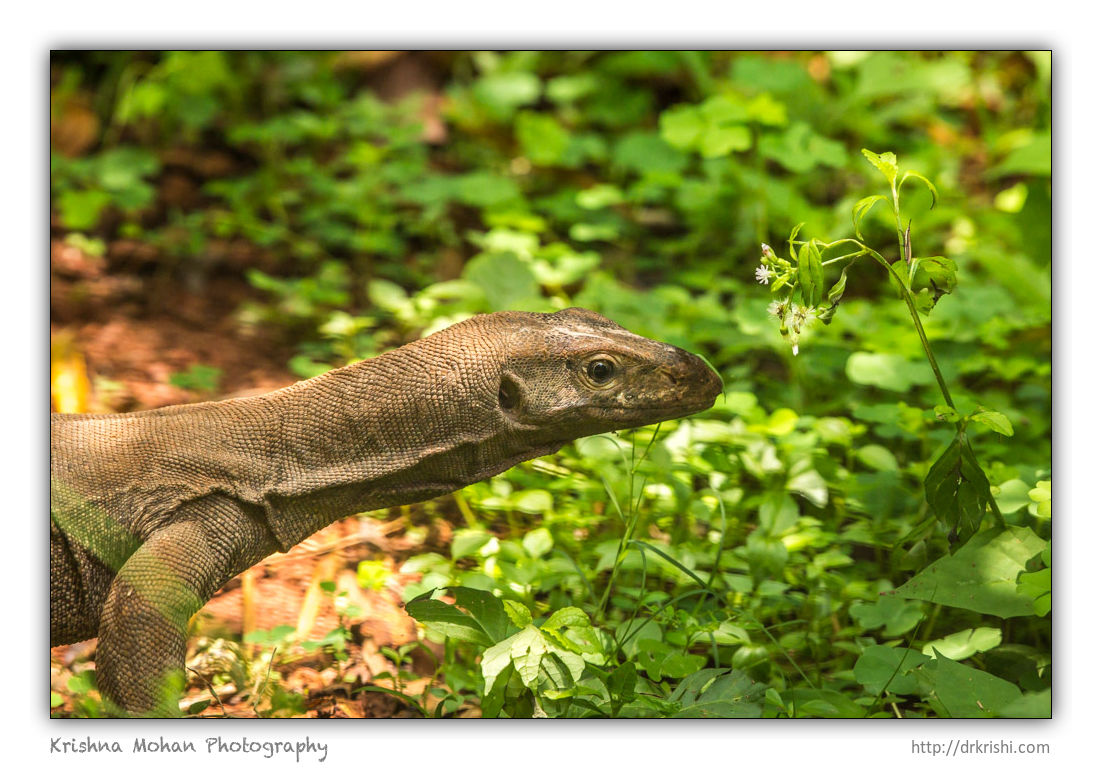
I have a wild Common Indian Monitor (Varanus bengalensis) in my garden. I had written on it in this blog around two years back. It has now grown up to be a gentle giant. Along with few toddy cats, dozen snakes and a resident shikra, it forms a healthy population of predators in my half acre of urban wilderness. Every now and then I get to see it prowling our garden looking for insects or birds. It is usually shy and avoids humans. With a keen eyesight it can detect human movement nearly few hundred meters away. To capture it in camera, either I have to wait using a hide or use a long tele lens. I don’t follow the common practice of baiting for photography. In the past I missed photographing it several times, due to my own sloppiness.
On that day I was testing my new Canon EF 500mm f/4L IS II USM Lens for its focusing speed as well as closeup capture capability. I was waiting for birds near oleander bush. I noticed this Monitor approaching towards me. Luckily he did not notice my camouflaged presence. It was searching for arthropods among the leaf litter, a little far away. Being very close to me I had no option to capture it fully. I was fascinated by its unblinking eye and curious look those lips impart. After several minutes of patient capture I was finally able to get what I was hoping for – a monitor lizard curiously fascinated by the tiny juvenile short horned grasshopper.

Common Indian Monitor (Varanus bengalensis) or Bengal monitor, is a monitor lizard found widely distributed over South Asia. This large lizard is mainly terrestrial and grows to about 175 cm from the tip of the snout to the end of the tail. Young monitors may be more arboreal but adults mainly hunt on the ground preying mainly on arthropods but also taking small terrestrial vertebrates, ground birds, eggs and fish. Although large monitors have few predators apart from humans who hunt them for meat, younger individuals are hunted by many predators.
Young monitor lizards are more colourful than adults. Young have a series of dark crossbars on the neck, throat and back. The belly is white, banded with dark crossbars and are spotted with grey or yellow (particularly in the eastern part of the range). On the dorsal surface of young monitors, there are a series of yellow spots with dark transverse bars connecting them. As they grow up the ground colour becomes light brown or grey and dark spots give them a speckled appearance.
Bengal monitors have an external nostril opening or nare that is slit like and oriented near horizontal and positions between the eye and the tip of the snout. The nares can be closed at will especially to keep away debris or water. Like other varanids, Bengal monitors have a forked tongue that is protruded in the manner of snakes. The function is mainly sensory and is not very involved in the transport of food down the throat. Bengal monitors have fat deposits in the tail and body that serve them in conditions when prey are not easily available.

The lungs have spongy tissue unlike the sacs of other saurians. This allows for greater rates of gas exchange and allow a faster metabolic rate and higher activity levels. Like all varanids, they have subpleurodont teeth, meaning that the teeth are fused to the inside of the jaw bones. The teeth are placed one behind another and there are replacement teeth behind and between each functional tooth (polyphyodont). The maxillary and dentary teeth are laterally compressed, sometimes with a slightly serrate cutting edge while the premaxillary teeth are conical. There are 78 premaxillary teeth, 10 maxillary and 13 dentary teeth. Replacement teeth move forward and about 4 replacements happens each year for a tooth. There are mandibular glands that produce secretions at the base of the teeth and although some varanids have been shown to have a venom, no toxicity has been reported in the Bengal monitor. Folk belief has it that they are venomous and in Sri Lanka it is believed that their breath is poisonous. In Rajasthan, it is believed that they are venomous only during the rainy season.
Bengal Monitors are usually solitary and usually found on the ground although the young are often seen on trees. Bengal monitors shelter in burrows that they dig or crevices in rocks and buildings, whilst clouded monitors prefer tree hollows. Both races will make use of abandoned termite mounds. Bengal monitors, like other varanids show true sleep at night and are diurnal, becoming active at around 6 AM and bask in the morning sun. They are usually shy and avoid humans. They have keen eyesight and can detect human movement nearly 250 m away. When caught a few individuals may bite but rarely do so. Captives have been known to live for nearly 22 years.

Large adults may ascend vertical tree trunks where they sometimes stalk and capture roosting bats. Their normal prey consists of beetles, grubs, orthopterans, scorpions, snails, ants and other invertebrates. Vertebrate prey is comparatively rare and includes frogs, fish, lizards, snakes and rodents. They sometimes feed on dead animals.

